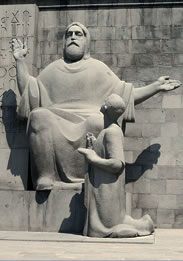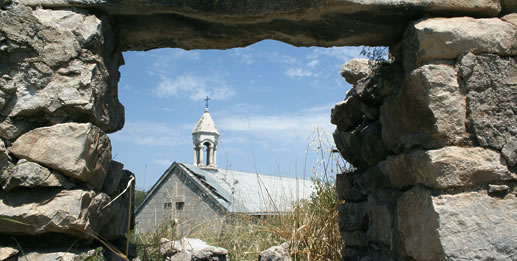Amaras and Armenian Alphabet
In contrast to most peoples around the world, Armenians have their own unique alphabet, which was created — or, perhaps, developed from an earlier, less perfect prototype — in the 5th century, between 404 AD and 406 AD. And Nagorno Karabakh’s Amaras Monastery is known for hosting the very first school where that new alphabet was used for teaching by its creator, St. Mesrob Mashtots — Armenian linguist, theologian, evangelizer and hymnologist, and, undoubtedly, one of the most outstanding inventors in human history. [1]
St. Mesrob was born in 361 AD or 362 AD in the village of Hatsekats in Armenia’s southwestern province of Taron — far from modern-day Nagorno Karabakh — in the family of a wealthy farmer named Vardan. He died on February 17, 440 AD in Vagharshapat, capital of the Kingdom of Armenia of the time. St. Mesrob’s sepulcher is located inside a large memorial church in the town of Oshakan, 30 miles from Armenia’s capital city of Yerevan.
In addition to the Armenian Alphabet, St. Mesrob is credited with the invention of separate scripts for two other languages — Georgian and so-called Gargarean (a dead North Caucasian language). Not surprising, both the Gargarean alphabet and the early version of the Georgian script, known as Asomtavruli, bear striking graphical similarity to the Armenian Alphabet. For his evangelism and the translation of the Holy Bible into Armenian, Mesrob Mashtots was elevated to the rank of saints by the Armenian Apostolic Church. St. Mesrob authored a number of religious hymns, known in Armenia as sharakans and taghs, which are among the oldest examples of music available today. The hymn Ankanimq, dedicated to the Holy Virgin, can be heard in Armenian churches every day.
There are several historical sources about the life and accomplishments of this spectacular individual. Mashtots’ biography was written by his disciple Koryun in the 5th century, and is called “The Life of Mashtots” (Armenian: Վարք Մաշտոցի). [2] Armenia’s foremost historian, Movses Khorenatsi (c. 410–490s) — another disciple of Mashtots — dedicated several chapters in his “History of Armenia” to his beloved mentor. [3]
Similarly to St. Gregory the Enlightener, who founded the Amaras Monastery in the beginning of the 4th century, Mesrob Mashtots undertook several journeys to Armenia’s eastern provinces of Artsakh and Utik — modern Nagorno Karabakh. They are described in chapters 27, 28 and 29 of Book One, and chapter 3 of Book Two of the 7th century manuscript known as “The History of the Province of Aghvank” (Armenian: Պատմություն Աղվանից Աշխարհի). [4] The authorship of the book is attributed to two early-medieval natives of Nagorno Karabakh — Movses Kaghankatvatsi and Movses Daskhurantsi. The authors refer to Mashtots as “saint,” “evangelizer,” and “enlightener,” and give impressive details about his missionary expeditions.
Overall, St. Mesrob made two trips to Armenia’s east. He toured not only Artsakh and Utik but also pagan territories that located to the east and north of the River Kura. Similarly to St. Grigoris of Amaras, Mashtots reached the foothills of the Greater Caucasus and studied North Caucasian languages in order to convert heathen tribes to Christianity.
An Armenian Alphabet Before St. Mesrob: the Mystery of Bishop Daniel’s Script
In 301 AD, the Kingdom of Armenia became the first state in the world that adopted Christianity as official religion. In 387 AD, however, Armenia entered a difficult period in its history. Armenia was losing its independence, as Persia and Byzantium conspired to divide the country. Christianity began declining in Persia-influenced part of Armenia, and in many provinces people revived pagan traditions. At that time, Mesrob Mashtots held the position of secretary and interpreter at the royal court in the capital city of Vagharshapat. He received his primary education at a Greek school back home in Taron, and was fluent in Greek, Persian and Syriac. St. Mesrob’s biographer Koryun described St. Mesrob as a valiant warrior and talented administrator who earned respect at the court both for his good knowledge of martial arts and his personal skills.
Mashtots’ initiative to create a separate alphabet for Armenians was driven by two concerns. First, Armenians could not read the Holy Bible in Greek or Syriac, nor could they understand sermons in those languages, a factor that accelerated the erosion of Christian faith in the countryside. The second factor was a renewed threat of cultural assimilation due to the stronger role of Syrian clergy and pro-Persian feudal lords in Armenia, a kingdom whose independence was visibly eroding. St. Mesrob grasped the full scope of these problems when, in around 395 AD, he temporarily left the royal court on an evangelizing mission to Armenia’s province of Syunik (today’s Armenia’s easternmost province) and the neighboring district of Goghtan (in present-day Nakhichevan, Azerbaijani Republic).
Upon his comeback to the capital city of Vagharshapat, Mesrob Mashtots met with Katholikos Sahak Partev (338 AD – 439 AD), the head of the Armenian Church, who offered St. Mesrob his full support. Sahak Partev was from the family of St. Gregory the Enlightener, the founder of the Amaras Monastery, and is usually credited as a co-author of the Armenian Alphabet. Similarly to St. Mesrop, Sahak Partev was canonized by the Armenian Church, and is often referred to as Sahak the Great.
Armenian Church’s formal endorsement of Mashtots’ proposal at its synod coincided with King Vramshapuh’s return to the capital city from his trip to Mesopotamia where the Armenian monarch tried to mediate a controversy connected with the exile of St. John Chrysostom by Aelia Eudoxia (died in 404 AD), the Empress consort of the Byzantine Emperor Arcadius.
Medieval authors report that while in Mesopotamia, King Vramshapuh was informed about the existence of a certain old Armenian script, in possession of Bishop Daniel of Edessa. When the king learned of the synod’s decision, he dispatched his confidante Vahrich Khaduni to Mesopotamia to bring a sample of Daniel’s letters to the royal court for inspection by St. Mashtots and St. Sahak.
The origin of the Danielian script remains a matter of intense academic debate, since no samples of it survived. It is known — from Koryun and Movses Khorenatsi, and other authors — that the script had been adapted for Armenian. The letters were also arranged according to the order of the Greek alphabet, a pattern that St. Mesrob used for all of the three alphabets he created. The most common hypothesis about the source of the Danielian script suggests that it represented an earlier Armenian writing system, based on Semitic calligraphy, which was abandoned in ancient times due to its main shortcoming — inability to correctly reflect the phonetic structure of Armenian, a complex Indo-European language. Or, alternatively, it was forgotten due to the failure of the state to support its spread and popularization.
St. Mesrob’s disciple Koryun details that when the Danielian script was brought to Armenia, his tutor began using the letters without delay. However, the inherent imperfections of the Danielian writing system rendered St. Mesrob’s teaching and translation efforts unproductive. After two years of struggling with Bishop Daniel’s script, St. Mesrob left Armenia on his own trip to Mesopotamia — to seek guidance from Greek and Syrian rhetoricians in the cities of Edessa and Samosata. And it was in Samosata, in 406 AD, where, after many discussions and consultations with the top minds of his time, St. Mesrob came up with the final version of the Armenian Alphabet. Medieval historians never failed to depict this event as an expression of divine will.
Masrop Mashots in Artsakh and Utik — Early Medieval Nagorno Karabakh
Koryun reports that immediately after the invention of the Armenian alphabet in Samosata, Mesrob Mashtots embarked on several successive missionary voyages, starting with the most difficult task — strengthening Christianity in Armenia’s unruly and mysterious province of Mokk, also known as the Land of the Marrs.
The Armenian historian Movses Kaghankatvatsi tells in his “History of the Province of Aghvank” that after St. Mesrob’s return to Armenia from a pilgrimage to Jerusalem, he embarked on his first journey to the Eastern Side of Armenia. That term in the Middle Ages designated historical Armenia’s provinces of Artsakh and Utik, on whose lands the present-day Nagorno Karabakh Republic was proclaimed in 1991. After the partition of Armenia in 387 AD, Artsakh’s and Utik’s Armenian rulers — the Arranshahik dynasty — exploited the weakened status of the king of Armenia and the lack of unity among Caspian and Caucasian tribes by launching an ambitious expansion program. They built a large state, known as the Kingdom of Aghvank, merging Armenia’s provinces of Artsakh and Utik with eastern territories that lay in the triangle formed by the River Kura — the traditional boundary of Armenian ethnic presence in the east — the coastline of the Caspian Sea and the mountains of the Greater Caucasus. The Kingdom of Aghvank continued to maintain close political, ecclesiastical and military ties with Armenia. Aghvank’s historian Movses Kaghankatvatsi suggests that the term Aghvank originated from the Armenian word aghu (աղու, meaning kindhearted), a tribute to the nickname of the region’s first ruler and the eponymous founder of the Arranshahik dynasty — Prince Arran.
St. Mesrob’s mission was received with enthusiasm by Artsvaghen (Armenian: Արծվաղեն), King of Aghvank, and the spiritual leader Bishop Yeremiah. Kaghankatvatsi writes that from Artsakh, St. Mesrob and his disciples traveled north, to the foothills of the Great Caucasus populated by non-Armenian tribes, and preached the Holy Gospel among Gargarean highlanders and Hephthalite nomads, effectively repeating St. Grigoris’ missionary expedition one century earlier. The “History …” maintains that St. Mesrob preached the Holy Gospel to the highlanders “in their own native tongues.” [5]
Mashtots’ second trip to Artsakh started with its northern sub-province of Gardman (modern Azerbaijan’s districts of Dashkesan, Shamkhor, Kedabek and Göygöl that were populated by Armenians before 1989) where “pagan creed was still practiced.” St. Mesrob was received by Gardman’s ruler Prince Khours — the same Prince Khours who was among the co-signees of the Constitution of Aghven. Known to be Armenia’s first known legal code, the Constitution was commissioned by Vachagan II the Pious, King of Aghvank, earlier in the fifth century. [6] The Targmanchats Monastery dedicated to St. Mesrob Mashtots and St. Sahak Partev — known together as the targmanichk (Armenian for translators) — was built in the 5th century by the rulers of Gardman on the site where St. Mesrob held his sermons. It stands to this day near the village of Khachabak (Kushchi) in the Dashkesan district of Azerbaijani Republic.
It is not exactly clear if the foundation of the first school at Amaras took place during St. Mesrob’s first or the second trip to ancient Nagorno Karabakh. Movses Kaghankatvatsi states that during the first trip St. Mesrob lived near the town of Gis (likely to be the historical village of Gishi, presently in the Martuni district of the Nagorno Karabakh Republic), hiding from mountain lords angered by the saint’s passionate preaching. Gishi is located very close to the Amaras Monastery. However, it was the second trip to Artsakh that Movses Kaghankatvatsi designates in Book II as the one during which St. Mesrob opened new schools in Artsakh. The first effort to establish country-wide schools was made during the reign of King Artsvaghen’s predecessor, Armenia’s legendary monarch Vachagan II the Pious.
Movses Kaghankatvatsi also mentions in Book II of the “History of the Province of Aghvank” (chapters 27, 28 and 29) that after St. Mesrob’s departure from the region, his pupils stayed in Artsakh and Utik, continuing the saint’s evangelizing and cultural mission. The author gives impressive details about the martyrdom of a young woman named Taguhi (Թագուհի, an Armenian first name literally meaning Queen), who was helping St. Mashtots’ disciples.
Taguhi hailed from a family of landed noblemen — azats (Armenian: ազատ, meaning “free”) — and was born in the village of Baghink (Armenian: Բաղինք) in the province of Utik. Kaghankatvatsi mentions that a maraudering army from the north once invaded the province of Artsakh on the day of the Holy Easter, and Taguhi was taken prisoner together with St. Mesrob’s pupils and other inhabitants of the district of Mets Kvenk (Armenian: Մեծ Կուենք). She was tortured and killed after refusing to become a concubine for the leader of the invading army. On the night that followed Taguhi’s martyrdom, the invaders saw beams of light coming from heaven, illuminating the place where Taguhi’s had martyred. At the same time, pieces of Taguhi’s cloths scattered around on a hill began to flicker like stars. The pagan invaders froze in awe of the sight of God’s sign. They repented their sin and came to accept true God. The hill subsequently was named Asthablour (Armenian: Աստղաբլուր), meaning Star Hill. [7] Later, a chapel commemorating Taguhi was built on Asthablour. The chapel’s ruins are near the historical town of Haterk, presently in the Mardakert district of the Nagorno Karabakh Republic.
[1] Viviano, Frank (March 2004). The Rebirth of Armenia (article). National Geographic Magazine
[2] Koriun. The Life of Mashtots. Translated from Old Armenian by Bedros Norehad, Yerevan, 1981
[3] Moses Khorenatsi. History of the Armenians. Translated from Old Armenian by Robert W. Thomson. Harvard University Press, 1978
[4] Movses Kalankatuatsi. History of the Province of Aluank, translated from Old Armenian by Sh. V. Smbatian. Yerevan: Matenadaran (Institute of Ancient Manuscripts), 1984
[5] Movses Kalankatuatsi. History of the Province of Aluank, translated from Old Armenian by Sh. V. Smbatian. Yerevan: Matenadaran (Institute of Ancient Manuscripts), 1984, Book I, chapters 27, 28, 29, in Russian
[6] Movses Kalankatuatsi. History of the Province of Aluank, translated from Old Armenian by Sh. V. Smbatian. Yerevan: Matenadaran (Institute of Ancient Manuscripts), 1984, Book II, chapter 3, in Russian
[7] Movses Kalankatuatsi. History of the Province of Aluank, translated from Old Armenian by Sh. V. Smbatian. Yerevan: Matenadaran (Institute of Ancient Manuscripts), 1984, pages 62-63, in Russian




